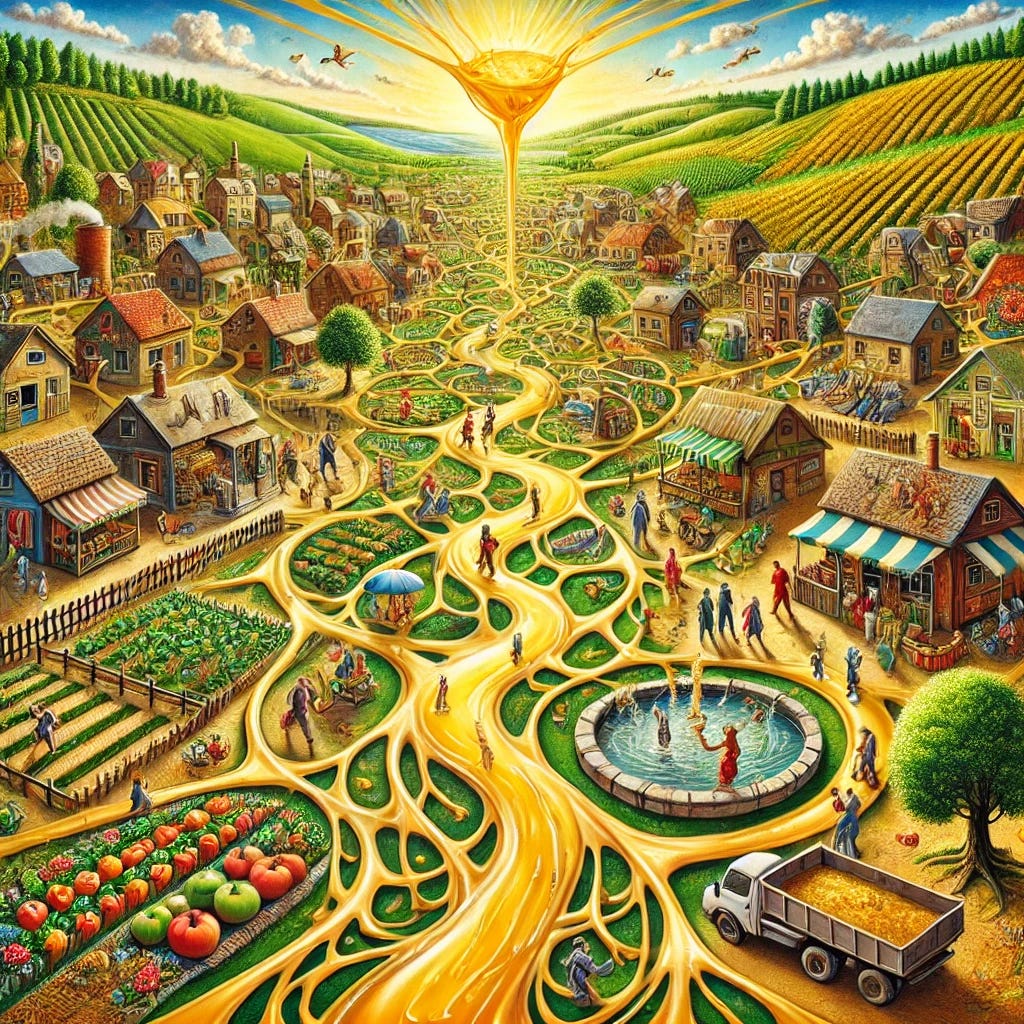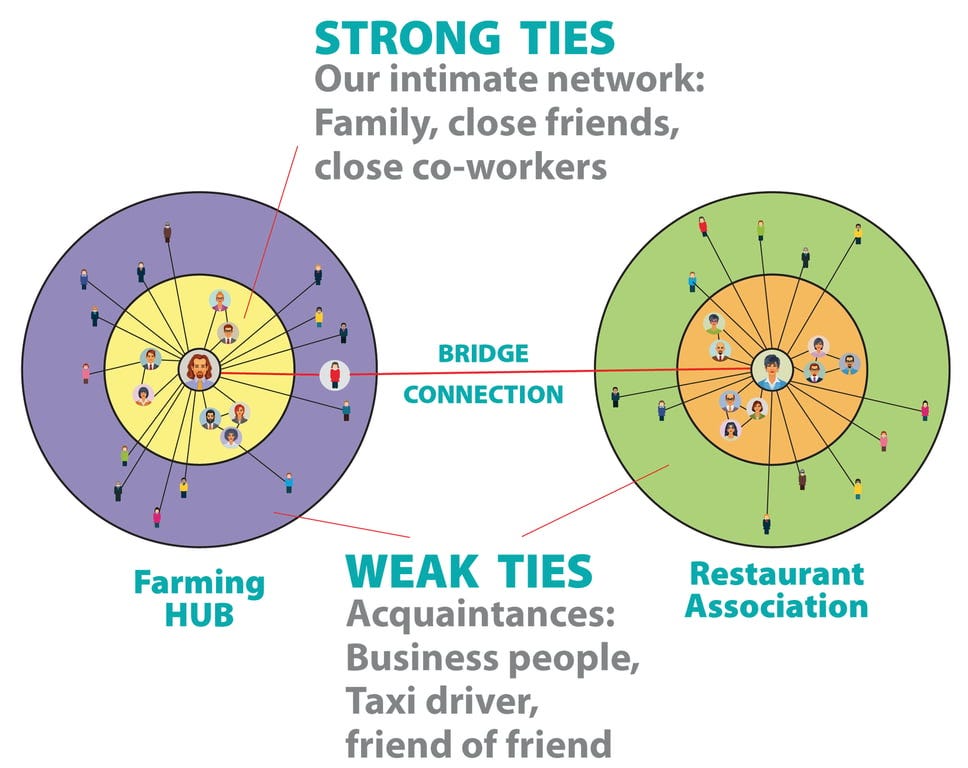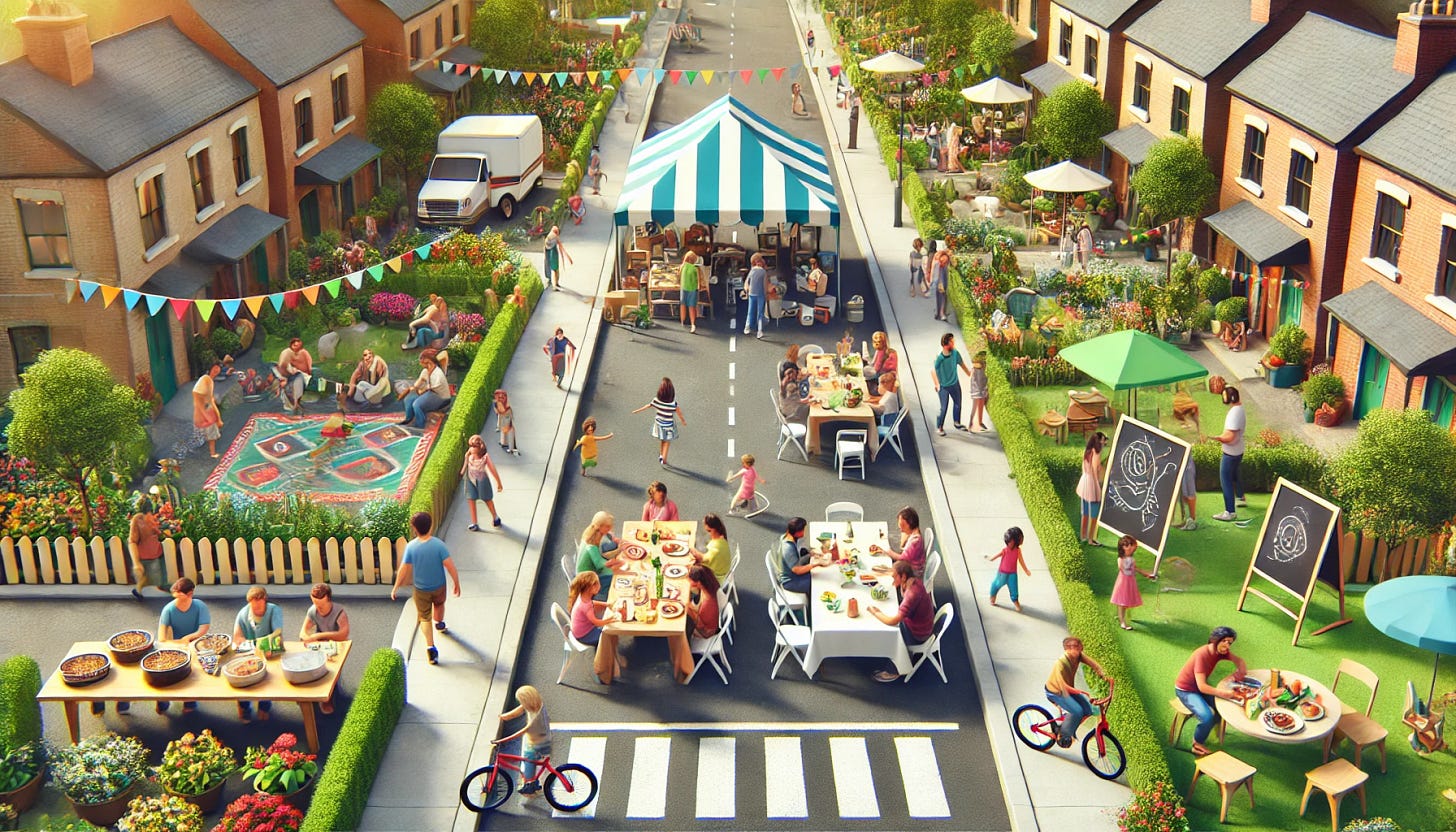Connecting the Good: Using the Internet to Serve the “Outernet” Chapter 11, Part1
Welcome to the Birthing the Symbiotic Age Book!
NEW here? — please visit the TABLE OF CONTENTS FIRST and catch up!
You are in Chapter 11, Part 2, Connecting the Good: Using the Internet to Serve the “Outernet”
Chapter 11 posts:
Building a “Super-Highway of Love”… One Sphera is Born … The Currency of One Sphera: TRUST
OneSphera in Action – Putting It All Together… The Future of OneSphera
Are you trying to figure out where this is All Going? Read Building Bridges to a New World — embodying the Transcendent through the nodes of intersection within local, grassroots-empowered community networks.
Voice-overs are now at the top of my posts for anyone who doesn’t have the time to sit and read! Also, find this chapter post and all previous posts as podcast episodes on
Spotify and Apple!
REMINDER of the READER SURVEY
Previously, at the end of Chapter 10, Part 8
As I reflect on the decades, I am convinced even more about the need to connect with the spiritual aspect of our nature and use the energies of Love to unite our immediate communities.
Imagine if we each made this absolute commitment! We will witness the global emergence of thousands of local communities coming together, an unnamed eruption of spirit, transforming the battlefields of this world.
So ask yourself …
Would you like to play some part – large or small – in transforming your region and networks into thriving Cultures of Connection? We will explain in deeper detail how these Symbiotic Circles operate and how to set one up in your community.
First, however, I want to discuss how our Conscious Community Network sought to apply technology to Connect the Good, the lessons we learned, and the exciting prospects for social media and other technologies to become our servants instead of our masters.
INTRODUCTION
In November 2013, we celebrated the tenth anniversary of our Conscious Community Network, which we had “rebranded” as “Connecting the Good.” Over these ten years, we had created four successful Symbiotic Networks—a “new wineskin network” infrastructure based on a growth hierarchy rather than a dominance hierarchy.
At the time, we called it a “Community Ark" to facilitate and accelerate the positive connections and collaboration amongst those already involved and those who wanted to be active in our Northern Nevada region.
By supporting local businesses, local food, neighbors networks, and the Arts, we had helped “flatten” the hierarchies. Ordinary citizens began to feel a sense of agency and even some of that “universal fellow feeling” that the original promoter of free markets, Adam Smith, wrote about.
Many of the anti-war activists who sparked our first conversations in 2003 had morphed into “localization” bridge builders and “regeneration” and other “prosocial” activists, finding it more productive to proactively build what we DO want than reactively fight against what we don’t.
While most other cities of similar size and population had gone further down the path of extraction and “trickle-down” economics, Reno and its vicinity were experiencing the opposite — the bubble-up economics of a “people’s free market.”
That’s where the local economy—particularly the local food system—is so vital that prosperity bubbles up from the bottom. Thriving producers get paid for their produce, and it enters a new system of intentional mutual benefit and local markets. Wealth then makes its way up the “food chain” and continues through the community as more businesses, organizations, and even local governmental institutions “buy local.”
The idea of re-localization has become mainstream since we began our movement in Northern Nevada in 2003.
Whether it’s independent business networks, localism, community-based economies, main street movements, regenerative communities, resilient communities, economic re-localization, bioregionalism, or circular economies, there is an ever-growing awareness that global problems can only be effectively addressed locally.
I believe the most promising and balanced concept to emerge is Cosmo-Localism, which reflects two seemingly opposing ideas: Cosmopolitanism (global) and Localism (local).
It is a restatement of an old idea - based on the Ancient Blueprint:
a Commonwealth of Village Republics.
Cosmo-localism is a system that blends global cooperation with local action. It encourages local communities to build, strengthen, and manage their own decentralized economic and political institutions while staying connected to more extensive global networks. It focuses on local people in local regions having greater control over their local economies and cultures while linking them to a more comprehensive, worldwide system.
Using technologies like blockchain, distributed ledgers, and peer-to-peer networks, Cosmo-localism encourages what I have called the Network Commons, as I’ve described previously:
"A Network Commons represents a community-based collaborative initiative where nonprofits, private for-profit enterprises, religious organizations, civic entities, mutual aid and gifting groups, cooperatives, and public resources are intentionally interconnected, shared, and governed by an engaged community of stakeholders."
By combining local economic and political independence with global connection and support, communities are strengthened, and systems become more resilient, particularly as global supply chains are in crisis and breaking down. This approach also aligns well with bioregionalism, with a laser beam focus on a smaller “micro-bioregional” scale (villages, towns, cities) using local resources and living ecosystems to build regenerative cultures and communities.
This framing helps us rethink community planning, considering imports and exports while emphasizing ecological balance, well-being, and global connections. While combining global awareness and local agency might seem like a novel approach in this era of top-down institutions and “big everything,” it’s hardly a new idea.
It reflects Mahatma Gandhi’s vision of a Commonwealth of Village Republics and Dr. Ari’s lived experience in Sri Lanka, where the Sarvodaya Shramadana Movement has already built such a system through their national network of 5,000 community-based economies.
So, we certainly aren’t reinventing the wheel!
It had already been built.
And, like all “convergent” ideas, it crosses religious and secular lines. It is even consistent with the Catholic Church’s social teaching (beginning with the writings of Pope Leo XIII in his 1891 encyclical Rerum Novarum) regarding the principles of Subsidiarity and Solidarity.
Subsidiarity, as you may remember from Chapter 6, was further developed by Pope Pius XI in his encyclical Quadragesima Anno: “It is an injustice, a grave evil and a disturbance of right order for a larger and higher organization to arrogate to itself functions which can be performed efficiently by smaller and lower bodies.”
Solidarity is “a moral virtue cultivated through a firm and persevering determination to commit oneself to the common good.” This commitment to the benefit of all, like charity, “begins at home” and radiates outward from the Virtues practiced individually and extended to the entire community.
Indeed, G.K. Chesterton, a famous Christian author who wrote in the early 1900s, called this type of decentralized political and economic system Distributism. One of his most famous quotes bears repeating: “The Christian ideal has not been tried and found wanting. It has been found difficult and left untried.”
Maybe, in these trying times, approaches like Cosmo-localism and Symbiotic Networks offer a new opportunity to give the Christian ideal—Divine Love made real through actions in the world—another try, above and beyond any religious differences or political capture.
Even though Cosmo-localism wasn’t on our radar conceptually in 2013, we recognized the need for local economic and political autonomy and were ready to take the next steps.
So now, ten years into our experiment in Symbiotic Culture and Community, two other questions emerged.
The first question is, how do we continue to extend mutual benefit even deeper into our community?
The second question is, how do we use technology to spread these networks
so they can emerge worldwide?
In the previous chapter, I discussed the Connections Gatherings and the Arts Festival, neither of which proved to be the “Holy Grail for building symbiotic community.”
However, we kept moving forward, intending to proliferate and accelerate mutual benefit throughout the region. Even though we didn’t have many of the frames and phrases I’ve introduced in this book – Ancient Blueprint … Symbiotic Culture DNA …wineskin networks… Culture of Connection – Fractal Community Empowerment — we intuitively sensed that our work was about connecting the “islands of coherence” already present in our community.
Thus, our rebranding as Connecting the Good. In fact, our regular monthly breakfast and lunch meetings, which outlived the Festival and even the Connections Gatherings, became a laboratory for accelerating community connections that could build a resilient “virtuous economy” and provide direct support to groups working to uplift “the least of us.”
This was at a time when social media was becoming prominent, and I wondered if there was a way we could use digital technology on the Internet to deepen our connections on the “Outernet.”
Could we use collaboration online to drive the acceleration of
real-world community resilience and self-sufficiency?
Before I discuss how we sought to apply technology to accelerate and amplify the well-being in our community and region, I want to step back for a moment and discuss the all-important foundation for using technology to build a Culture of Connection.
As we’ve seen over the past decade or two, inside the Culture of Separation, social media has been used to impose narratives, create separation, amplify echo chambers, make users addicted to them, and make us the “product” by extracting our information for sale – all the while not being rooted to any place.
To the extent we are using it, it is using us — and enslaving us.
So, how can technology be an extension of not just the human mind but also the human heart?
How do we build technology that emerges from the Ancient Blueprint?
TRUSTED CONNECTIONS at the ROOT of COMMUNITY
We can begin with a powerful idea introduced in Chapter 7 – trusted third-party connections. As you may remember, we built our Symbiotic Networks in Reno “one conversation at a time.” I began by reaching out to citizens and business, nonprofit, religious, local government, and community leaders I knew who were “trusted connections.”
After establishing rapport, I invited them to invite THEIR trusted connections, and we moved from connecting individual to individual to connecting group to group, network to network, and the whole community.
You may also recall the term “weak ties” – that is, the individual or individuals who, through their trusted connections, build a bridge from one silo or networked silo to others. According to Stanford sociologist Mark Granovetter, those looking for jobs or mates generally don’t find them in the communities they are already part of (their close “Tribe” or kin) but need to connect with an adjacent community of similar people they don’t yet know.
And Even before Symbiotic Networks connected communities, “weak ties” and trusted third-party connections have historically enhanced human well-being and laid the foundation for all local community life.
Consider this simple example.
Two friends are getting together for coffee. One is recently out of a relationship and again looking for a partner. The other thinks of someone who might be a perfect match. A blind date is set up. This is a trusted third-party connection. It’s not some stranger you meet in a bar or on the street. The potential date has the stamp of approval from a trusted friend.
This is the direct transference of trust from a bridging connection.
Now, blind dates like this may not end up as long-term relationships, although some do. And when they do, think of it as a “frozen asset”—in this case, the opportunity for mutual love—that gets liberated. Imagine those individuals not meeting, and the love and richer lives they share simply not happening.
Think of all the other billions of connections that can be and already are being made this way – daily! :
Finding a dream job
Opportunities to volunteer and be of service in the community
A place to live
Collaboration to create a new project or enterprise
Opportunities to share one’s goods and services
A new best friend
Helping a neighbor
Discovering a mentor
Connecting with others to play tennis or pickleball, walk dogs, or go to a concert
Each of these connections enriches everyone involved, including the one doing the matchmaking. There doesn’t need to be any “payback” or brownie points. Seeing someone smile because of a spontaneous act of generosity or care seems to evoke a sense of “all is well.”
I believe what I am describing is an innate human drive toward communion and connection that can’t be explained ONLY by biology, materialist concepts, or even social constructs like “enlightened self-interest,” “reciprocal altruism,” or “group selection.”
People need people, and because of that, making these connections is part of a deeper spiritual pattern implanted within us as human beings that reflects the Ancient Blueprint and need for kinship and community.
This desire to build bridges and extend benefits is ENDEMIC to being human.
While the motivation is usually to achieve results—like the above-mentioned job or partner—these acts, of what Pope Benedict called Gratuitousness, acts of total generosity, are fundamentally an example of intentional mutual benefit. It’s mutual—as one receives a tangible benefit, the other experiences the spiritual pleasure of doing a kind act.
That reminds me that one of the key pillars of Sarvodaya is what they call “Empathetic Joy” (experiencing joy in the joy of others)—part of a deeper “personality awakening” that Dr. A.T. Ariyaratne taught us is both foundational to and part of the practice of building on-the-ground community networks.
As Gandhi once said, if not for these billions of acts of kindness, generosity, and love happening like this every day, we would have destroyed ourselves long ago.
People naturally desire to help others without any need for reciprocity—just because it feels good, is the right thing to do, and we sense this is a pathway to a more abundant life.
This unselfish generosity is a demonstration of Love in action, a gift without any expectation of return. Pure generosity is a Virtue, a natural quality of being human that radiates from the Ancient Blueprint, embodies within us, and then expresses itself as Divine Love in the world.
This emerges collectively during natural disasters like hurricanes, earthquakes, or floods. The common plight brings out a generous impulse that, unfortunately, tends to recede when the flood waters do.
In Section 1 of the book, I asked whether it was possible to live this way 24/7. The answer is YES!
I contend that these other-serving acts are the currency of the Culture of Connection — an expression of what C.S. Lewis described as the “Way in which things everlastingly emerge, stilly and tranquilly, into space and time.”
I refer to this as an Ancient Blueprint, where we are all connected, and out of that field of mutual benefit, all concerned are enriched.
OK, what does this have to do with using technology to connect communities?
Simply put, it means the technology of the Culture of Connection must be founded on the Ancient Blueprint and Love. The kinship we extend to those we already know and Love must now be extended to the community at large in Symbiotic Kinship—including those we don’t know and those we may not like.
Stay tuned for the next post, Chapter 11, Post 2… Building a “Super-Highway of Love”… One Sphera is Born
PREVIOUS POST
TABLE OF CONTENTS
NEXT POST







This is AMAZING!! Thank you for putting into words what my being has been longing. I’ve been sending this to all of my people. Here, here, this is what I’ve been trying to convey.